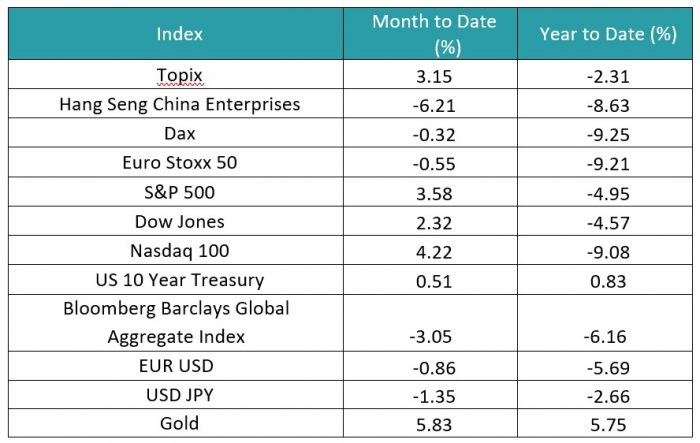MONTHLY NEWSLETTER – MARCH 2022
A summary of key events and market trends during the month of March
- Heading into the end of the first quarter of 2022 and the swift change in the investment and geopolitical landscape is remarkable.
- Financial markets have recovered well from the lows seen in February and March, and Ukraine and Russia are negotiating a peace which hopefully comes through sooner rather than later.
- That being said equity markets continue to trade negative for the year with the Nasdaq and Dax down 9 % each and the S&P 500 down 5 %.
- This belies the level of churn we have witnessed and the net impact of higher rates and a flatter curve will likely be felt for some time as borrowers adjust to the new reality of normalization of interest rates.
- While the US rates markets now price in almost nine 25 basis point hikes over the next twelve months, Europe is expected to move out of negative rates by the end of the year.
- In the US various programs will now be actively allocating and spending the stimulus funds and this will lead to a strong growth impetus despite higher rates. In Europe we would expect to see the same from the higher defense and clean energy initiatives.
- Volatility is off the highs of the year but we would expect to see it the VIX in play given the geopolitical tensions and the adjustments to the current interest rate curve dynamics.
Onward and upward with interest rates …
Larger rate hikes are now being priced in … and earlier
Key Markets
Recap of the month …
Navigating rapidly rising interest rates and the unwind of central bank balance sheets was already a handful to which investors are now required to factor in geopolitical tensions and additional supply chain concerns. The same makes for an interesting combination of scenarios.
The NATO response to the Russian invasion of Ukraine has been quicker and stronger than most analysts and observers could have envisaged. And the impact of the conflict is being felt globally and more so in Europe which has heavy dependence on Russia for its energy needs.
Energy importing countries are at a large disadvantage given the spike in energy prices and, at the moment, OPEC countries have not evinced a particular interest to increase their output to pick up any of the slack. This in the longer term will lead to further development of renewable and clean energy technologies and we would expect companies operating in this space to perform well.
The US yield curve has flattened significantly over the least one month and currently the ten year US Treasury bond yields barely one basis point over the two year note. Multiple analysts are now expecting meaningful inversion of this part of the curve and would expect said inversion to signal a severe slowdown and recession. The Federal Reserve is now expected to hike interest rates around nine times over the next 12 months and likely higher after that. The discussions are also shifting to how many near-term hikes are likely to be of 50 basis points instead of the usual 25 basis point hikes.
We would not be surprised to see a faster hiking schedule. However, we do feel it is equally possible that the Fed pauses just shy delivering all the tightening the market currently expects. Financial conditions through wider bond spreads have already tightened and that too would factor into the Fed’s forward assessment.
Higher interest rates are likely to get businesses to re-evaluate their borrowing and spending plans. However, we would expect this to be only a marginal impact on companies that have strong tail winds of growth. These names would be primarily in the technology space and despite volatility in the short term would likely deliver strong results in the coming quarters.
As the exception, the Bank of Japan has been muted on the matter of rate hikes and instead is hardening its stance with regards capping the yield on the Japanese ten year bonds. This has played into a significantly weaker Japanese Yen. While the Yen has already weakened some five percent from the start of the year we would not expect this weakness to reverse until we note a policy shift to tightening.
The Volatility Index (VIX) has closely reflected the abb and flow of geopolitical concerns over the last month and after hitting a high of around 38 at the end of February has now settled back down just below the critical level of 20. Given the fluid geopolitical situation we would not be surprised to see volatility head higher in the short term and would use these opportunities to lock in attractive premium for portfolios.

